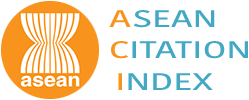การพัฒนาระบบเตือนภัยพื้นที่เสี่ยงภัยแล้ง โดยเทคโนโลยีภูมิสารสนเทศ จังหวัดนครสวรรค์
คำสำคัญ:
ระบบเตือนภัย , ภัยแล้ง , เทคโนโลยีภูมิสารสนเทศบทคัดย่อ
วัตถุประสงค์และที่มา : การวิจัยครั้งนี้มีวัตถุประสงค์ เพื่อพัฒนาระบบเตือนภัยพื้นที่เสี่ยงภัยแล้งแบบอัตโนมัติ โดยเทคโนโลยีภูมิสารสนเทศ บนฐานการประยุกต์ใช้ข้อมูลจากดาวเทียมจากหลายแหล่ง
วิธีดำเนินการวิจัย: การศึกษาครั้งนี้แบ่งปัจจัยที่ใช้ในการวิเคราะห์ออกเป็น 3 กลุ่ม ประกอบด้วยกลุ่มแรก คือ ปัจจัยด้านอุตุนิยมวิทยา ประกอบไปด้วย ข้อมูลปริมาณน้ำฝนรายวันจากดาวเทียม Himawari-9 ข้อมูลอุณหภูมิอากาศและข้อมูลความชื้นสัมพัทธ์ จากข้อมูลดาวเทียม Aqua ระบบ MODIS ปัจจัยกลุ่มที่สอง คือ ปัจจัยด้านชีวภาค ประกอบไปด้วย ข้อมูลดัชนีพืชพรรณ NDVI และข้อมูลดัชนีผลต่างความชื้น NDWI จากข้อมูลจากดาวเทียม Terra ระบบ MODIS ซึ่งปัจจัยด้านอุตุนิยมวิทยาและชีวภาค นั้นได้รับการประมวลผลแบบเรียลไทม์ในระดับรายวัน ด้วยภาษาไพทอน (Python) และปัจจัยกลุ่มที่สาม คือ ปัจจัยด้านลักษณะทางกายภาพของพื้นที่ ประกอบไปด้วย ระยะห่างจากเส้นทางน้ำ การระบายน้ำของดิน ความลาดชัน ความสูงของภูมิประเทศ ความหนาแน่นของเส้นทางน้ำ และขนาดของพื้นที่ลุ่มน้ำย่อย จากนั้นนำทุกปัจจัยมาวิเคราะห์พื้นที่เสี่ยงภัยแล้ง รวมถึง พัฒนาระบบเตือนภัยพื้นที่เสี่ยงภัยแล้งอัตโนมัติที่ให้บริการข้อมูลภูมิสารสนเทศผ่านเว็บไซต์โดยใช้ Geo-server เป็นเครื่องบริการข้อมูล และแสดงผลข้อมูล แผนที่ด้วย OpenLayers ซึ่งเป็นไลบรารีของภาษา JavaScript
ผลการวิจัย: จังหวัดนครสวรรค์มีพื้นที่ส่วนใหญ่เสี่ยงภัยแล้งในระดับปานกลาง จำนวน 2,114,591 ไร่ คิดเป็นร้อยละ 35.05 และพื้นที่เสี่ยงภัยแล้งในระดับปานกลาง จำนวน 1,810,103 ไร่ คิดเป็นร้อยละ 29.87 ของพื้นทั้งหมด พบมากอำเภอตากฟ้า อำเภอ ตาคลี อำเภอท่าตะโก อำเภอชุมตาบง อำเภอลาดยาว และอำเภอไพศาลี ซึ่งพื้นที่ส่วนใหญ่อยู่นอกเขตชลประทาน ส่วนพื้นที่เสี่ยงภัยแล้งต่ำ มีจำนวนพื้นที่ 918,031 ไร่ คิดเป็นร้อยละ 16.12 ของพื้นที่ทั้งหมด พบมากในอำเภอแม่วงก์ อำเภอชุมแสง และอำเภอแม่เปิน
สรุปผลการวิจัย: ระบบเตือนภัยที่พัฒนาขึ้นสามารถแสดงข้อมูลพื้นที่เสี่ยงภัยแล้ง ปริมาณน้ำฝน อุณหภูมิอากาศ ความชื้นสัมพัทธ์ ดัชนีพืชพรรณ NDVI และดัชนีผลต่างความชื้น NDWI ในระดับรายวัน ผ่านเว็บไซต์ https://hss.nsru.ac.th/droughtNS/ โดยผู้ใช้งานสามารถนำข้อมูลไปสนับสนุนการตัดสินใจและวางแผนการบริหารจัดการน้ำได้อย่างทันท่วงที
เอกสารอ้างอิง
AghaKouchak, A., A. Farahmand, F. S. Melton, J. Teixeira, M. C. Anderson, B. D. Wardlow, & C. R. Hain (2015), Remote sensing of drought: Progress, challenges and opportunities, Rev. Geophys., 53, 452–480, doi:10.1002/2014RG000456.
Borbas, E.,Seemann,W., Kern, A., Moy, L., Jun,L.,Gumley, & L and Menzel, W. (2011). Modis Atmospheric Profile Retrieval Algorithm Theoretical Basis Document Collection 6. Madison: University of Wisconsin-Madison.
Center Climatological. (2013). Climatological data of Thailand for 30-year period (1981-2010). Bangkok: Meteorological Development Bureau. (in Thai)
Cross-functional Team. (2007). Guidelines for runoff management for knowledge management in runoff management. Bangkok: Royal Irrigation Department. (in Thai)
Didan, K. & Munoz, A. B. (2019). MODIS Vegetation Index User’s Guide (MOD13 Series). Tucson:The University of Arizona.
ESRI. (2024). ArcGIS for Personal use Term License Subscription. USA. 614616822885
Gao, B.-C. (1996). NDWI—A normalized difference water index for remote sensing of vegetation liquid water from space. Remote Sensing of Environment, 57(3), 257–266. https://doi.org/10.1016/S0034-4257(96)00067-3
Kasikorn Research Center. (2023). Thailand’s Economy in the Second Half of 2023. Bangkok: KResearch. (in Thai)
Land Development Department. (2023). Forecast of drought in agricultural areas due to dry spells in 2023. Bangkok: Land Use Policy and Planning Division. (in Thai)
Land Development Department. (2021). Recurrent Drought-Prone Areas in Northern Thailand. Bangkok: Division of Land Use Policy and Planning. (in Thai)
Nakhonsawan Province Statistical Office. (2023). Nakhonsawan Province statistical report. Bangkok: Statistical Forecasting Division, National Statistical Office. (in Thai)
Office Agricultural Economics. (2023). AGRICULTURAL STATISTICS OF THAILAND 2022. Bangkok: Ministry of Agriculture and Cooperatives. (in Thai)
Phengphit, N. (2024). The developed of a warning drought system using geo-information technology, Nakhon Sawan province (Research reports). Nakhon Sawan: Nakhon Sawan Rajabhat University. (in Thai)
Pholgerddee, P. (2020). Application of geo-informatics technology to study vegetation index and humidity: A case study of drought in the special economic Eastern region of Thailand. International Journal of Agricultural Technology, 16(4), 917-936.
Piyapanee, W. (2023). Nakhonsawan Province Statistical Report. Nakhon Sawan: Nakhon Sawan Provincial Statistical Office. (in Thai)
Rachpilboo, N., Wongkoon, S ,& Chansury, W. (2017). The automatic assessment weekly of drought risk area with remote sensing technique. Journal of Remote Sensing and GIS Association of Thailand (RESGAT Journal), 17(Special), 334–344. (in Thai)
Royal Irrigation Department. (2021). Information of irrigation 2021. Bangkok: Royal Irrigation Department. (in Thai)
SA-NGUANSILP, C., Wijitkosum, S. & Sriprachote, A. (2017). Agricultural Drought Risk Assessment in Lam Ta Kong Watershed, International Journal of Geoinformatics, 13(4).
Sowcharoensuk, C. (2024). Drought and flood risk 2024: Impacts on agriculture and related industries. Bangkok: Krungsri Research Intelligence. (in Thai)
Suwarsono, P. K. (2009). Penentuan hubungan antara suhu kecerahan data MTSAT dengan curah hujan data QMORPH. Jurnal Penginderaan Jauh, 39(6), 32-42.
Tucker, C. J. (1979). Red and photographic infrared linear combinations for monitoring vegetation. Remote Sensing of Environment, 8(2), 127–150. https://doi.org/10.1016/0034-4257(79)90013-0.
Vasileios, P., Mahlatse, K., Mxolisi, M., Thomas, A., Cherif, I., Giovanni, L., Riccardo, O., Stergios, K., Maria, C., Ioannis, S., & Eleni, K. (2024). A drought monitoring and early warning service for food security in South Africa.Climate Services, 34 (2024), 1-11. https://doi.org/10.1016/j.cliser.2024.100463
Visara. (2013). Humidity conversion formulas calculation formulas for humidity. Helsinki: Vaisala Oyj.
Wijitkosum, S. (2021). Factor influencing land degradation sensitivity and desertification in a drought prone watershed in Thailand. International Soil and Water Conservation Research, 9 (2021), 217-228. https://doi.org/10.1016/j.iswcr.2020.10.005.
World Meteorological Organization (WMO). (2024). State of the Global Climate 2023. Geneva: WMO.
World Meteorological Organization (WMO) and Global Water Partnership (GWP). (2016). Handbook of Drought Indicators and Indices. Geneva, WMO
ดาวน์โหลด
เผยแพร่แล้ว
รูปแบบการอ้างอิง
ฉบับ
ประเภทบทความ
สัญญาอนุญาต
ลิขสิทธิ์ (c) 2024 คณะวิทยาศาสตร์ มหาวิทยาลัยบูรพา

อนุญาตภายใต้เงื่อนไข Creative Commons Attribution-NonCommercial-NoDerivatives 4.0 International License.
Burapha Science Journal is licensed under a Creative Commons Attribution-NonCommercial-NoDerivatives 4.0 International (CC BY-NC-ND 4.0) licence, unless otherwise stated. Please read our Policies page for more information




